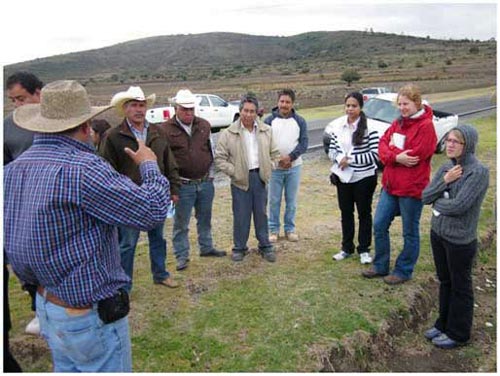 India has recently experienced a boom in cell phone use in the agricultural sector—disseminating information on anything from technology to agronomic practices, weather, or even market prices. Investigating this recent trend’s presence in Mexico, on June 26 a team of CIMMYT socioeconomists including Tina Beuchelt, Surabhi Mittal, Dagoberto Flores, and Jennifer Zehner visited the Chimalpa Valley in the municipality of Apan, state of Hidalgo, Mexico, an area largely known for being a barley production belt, to gauge the prevalence of cell phone use for agricultural purposes.
India has recently experienced a boom in cell phone use in the agricultural sector—disseminating information on anything from technology to agronomic practices, weather, or even market prices. Investigating this recent trend’s presence in Mexico, on June 26 a team of CIMMYT socioeconomists including Tina Beuchelt, Surabhi Mittal, Dagoberto Flores, and Jennifer Zehner visited the Chimalpa Valley in the municipality of Apan, state of Hidalgo, Mexico, an area largely known for being a barley production belt, to gauge the prevalence of cell phone use for agricultural purposes.
The trip involved a focus-group discussion with 12 farmers. The farmers were frustrated that extension services and information were not reaching them because of inadequate communication. They said they relied on their friends and family as their principle source of agricultural information. All participating farmers had cell phones, which they use for some agriculture-related purposes. Cell phone costs are relatively high, but the farmers save time and money by calling their technician, rather than having to travel by car to other towns seeking information. Apart from phone calls, there is not a great interest in sending or receiving agricultural information through SMS due to its high cost. Furthermore, it emerged that none of the farmers were using the existing SAGARPA SMS information service or were even aware of its existence.
As the CIMMYT team and farmers’ discussion progressed, farmers revealed that they would, indeed, like an agency that circulates relevant information, such as rainfall forecasts to make better planting decisions, crop prices, where to buy inputs, input applications, government subsidy programs, and relevant agricultural events. This information would allow farmers to be more efficient in their production. The farmers said they would also appreciate other modes of communication, such as a local agronomic television show or radio programs during the weekend from which they could obtain important agricultural information.
The farmers mentioned important constraints to information sharing, indicating the need for trustworthy external sources. They mentioned a lack of trust among neighboring farmers and that farming networks (or unions) are not well established. By the end of the discussion, farmers started showing more interest in how to obtain agricultural information via cell phone. While they were reticent about the use of cell phones and their cost, they mentioned that if cell phones could be used profitably, they might be willing to pay for such services in the future. This interaction between CIMMYT and the farmers is the initial step in understanding Mexican farmers’ perspectives towards cell phone use as a means of better communication and information dissemination.

